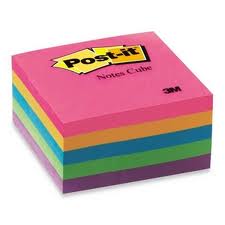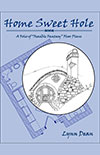A couple weeks ago, I mentioned here that I’ve been known to use Post-It Notes to plot out a story on the back of the door to my workroom. It’s a quick trick and a handy way to get ready for NaNoWriMo (or to stay on track if you’ve already started), so let me build on another article from the archives and show you how this can work.
- Getcha a big ol’ stack of Post-It Notes. It helps if you have stacks in three or more colors. We’ll get to the reason why in a bit.
- Write down an idea to start your story–a setting, a character, and a desire or problem. Don’t obsess too much about this, because you can always change it later. Just write down the starting point that’s in your head and stick it at the top of the door.
- Now cogitate a little about how you think the story ends. Again–a setting, character(s), and the desire fulfilled and/or problem solved. (That’s how we know the story’s over, right?) Jot it down and stick that note near the bottom of your door. Now you have a timeline, see?
- What goes in the middle? Ah! There’s the rub and reason that most people never actually write though many dream of doing so. But you are not so easily dissuaded! You can’t be daunted; you’re dauntless! Besides, you have mad creative skilz and an (almost) unlimited supply of Post-It Notes (and there’s more at the store). This is the time where you write down any crazy idea that pops into your head. The ideas don’t even have to come in any particular order, because you can move the sticky notes around any way you like.
- Maybe you’re one of those organized thinkers who start at the beginning and outline what comes next and next and then next until you reach “The End.”
- Maybe you play both ends against the middle, alternating the chronology of your story from next to next-to-last until the beginning and ending meet up.
- Maybe it would help you to imagine a high-drama mid-point, then go back and figure out how your characters got into that mess and how they get themselves back out.
- Maybe you’re sold on the 3-act play format. Figure out where your plot turns–what throws your hero into an adventure he can’t escape, when he decides to quit running and start fighting, the moment when all seems lost and then the point where there’s a glimmer of hope if they can just pull the mad scheme off.
- By this time, you know who those other people running around in your imagination are and how they fit into your story. THEIR story–where did they come from, what do they want, and what are they thinking–goes on the different colored Post-Its. You can also use the alternate colors to sketch out the dramatic sub-plot if you’re writing a romance or the romantic sub-plot if you’re writing an action drama.
Experiment all you like! If you don’t like the direction your story’s taking, or if it seems too “expected,” you can brainstorm brilliant new plot twists on Post-Its stuck right over the original notes so that you can always go back if things don’t work out. Or number the notes and then play around with the order of events.
Once you’ve got the main story line set up to your satisfaction, you can begin to intersperse the sub-plots. Is your hero smitten by the beautiful heroine from first meeting, or does he drag her along thinking she’s a nuisance until she saves his tail later in the tale?
When you think you’re done, do take a snapshot or transfer the notes to something more permanent. It would be a shame if the best-selling book of the year were blown away by a stiff breeze or mistakenly tossed in a frenzy of housekeeping!
















Speak Your Mind
You must be logged in to post a comment.